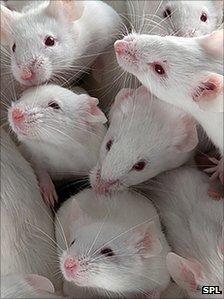Socialising enhances fat conversion and loss in mice
- Published

Mice with a more socially challenging lifestyle are more resistant to obesity
A socially active lifestyle can dramatically speed up weight loss through the burning of fat in mice, a study shows.
Researchers at Ohio State University in the US identified a link between the amount of social interaction in a mouse's environment and its weight.
Obesity in people worldwide is becoming a major health and economic problem; this new understanding, published in Cell Metabolism, could pave the way for socially-based therapeutic strategies to tackle it.
Fat can come in two types: energy-storing white fat, and energy-burning brown fat.
While we all have white fat tissue, the brown fat needed for weight loss is difficult to make. It is mostly found in babies, or in adults who have been exposed to extreme cold, where it is burned to keep them warm.
But the US team, led by Professor Matthew During, have found that relatively small changes in the physical and social living environment of mice can alter vast amounts of white fat to brown.
In contrast to the "couch potato" lifestyle of normal laboratory mice, experimental groups were housed in an "enriched" living environment - numbering 15-20 in large containers, furnished with running wheels, tunnels, huts, wooden toys and a maze.
This more physically complex housing for the lab mice not only increased the mental challenges posed, but also the amount of social interactions between individuals.
Despite being giving identical, unlimited food, the normal mice and those in the socially enriched environment showed marked differences in their weight.
This difference was reflected in the type and the structure of fat stored in the mice's bodies.
Professor During said that he was "amazed at the degree of fat loss that occurs." After just four weeks in the enriched environment, mice had lost on average 50% of their abdominal white fat.
Moreover, when fed on a high fat diet, the mice with a challenging social lifestyle were much less likely to put weight on. A higher body temperature in these individuals demonstrated that it was the all-important brown fat being burned that caused the weight loss.
Brain stimulation
The same team showed last year that a stimulating social environment can help improve brain health in mice, by causing the production of a substance known as Brain-Derived Neurotrophic Factor (BDNF).
They have now found BDNF is also responsible for starting the process whereby white fat is turned into burnable brown fat.
With this knowledge, the researchers say it should be possible advise a lifestyle change, or to artificially activate the conversion of fat in our bodies.
Humans are known to have BDNF, although investigation of the link between the brain and body fat is still in its infancy.
While simple drug treatments are still problematic, unable to specifically target the brain-fat link, Professor During hopes to develop minimally invasive neurosurgery to stimulate the BDNF production.
Social networks
Despite being carried out on mice, the findings offer insight into the link between loneliness and ill health in humans, potentially associating the rising obesity epidemic with the rise of online media and social networking in place of more dynamic, face-to-face interaction.
The research highlights the fact that social interaction can be challenging, and maintaining a network of friends can be stressful.
This stress is a positive thing for the body, prompting it to produce BDNF and convert the white fat to brown, preventing it building up and causing obesity.
Professor During said that "it is not the size of your social network, but its depth and complexity, and your level of engagement with that network, that counts."
He hopes that his research will help to communicate the impact of social psychology on health in the future, and promote lifestyle changes as an alternative to highly invasive gastric surgery.
- Published26 December 2010